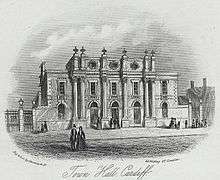City Hall, Cardiff
| Cardiff City Hall | |
|---|---|
  The City Hall logo; "VC" stands for Villa Cardiff. | |
| General information | |
| Architectural style | |
Listed Building – Grade I | |
| Official name | Cardiff City Hall |
| Designated | 25 January 1966 |
| Reference no. | 13744[1] |
| Town or city | Cardiff |
| Country | Wales, United Kingdom |
| Completed | 1906 |
| Cost | £129,708[2] |
| Client | Corporation of Cardiff |
| Design and construction | |
| Architect |
Henry Vaughan Lanchester James Stewart Edwin Alfred Rickards |

City Hall is a civic building in Cathays Park, Cardiff, Wales, serving as Cardiff's centre of local government since it opened in October 1906. Built of Portland stone, it is an important early example of the Edwardian Baroque style.
History

The complex replaced Cardiff's fourth town hall (which was located on the western side of St Mary's Street), built by architect Horace Jones c. 1850–53 (demolished 1913).
The competition to design Cardiff's fifth town hall and adjacent law courts was won in 1897 by the firm of Lanchester, Stewart and Rickards. Construction was carried out by local builders E. Turner and Sons.
Turned and Sons used the world's first all-electrically operated building site, including eight 5 ton cranes to lift the stone blocks. The total building cost was £129,708 (with the concurrently-built Law Courts next door costing £96,583).[2]
As Cardiff received its city charter in 1905 while construction was underway, the current building is known as City Hall.
Exterior architecture
Clock tower
The distinctive clock tower is 59 m (194 ft) in height has a 3.7 m-diameter (12 ft) gilded dial on each of its four faces. The clock mechanism includes an hour bell and four quarter bells which are each inscribed with mottoes in English or Welsh.[3]
Fountains and pool
In front of the entrance portico is a rectangular pool with fountains. They were created in July 1969 to mark the investiture of Prince Charles as Prince of Wales.[3]
Memorials
The building has two memorials. The memorial on the left is dedicated to Polish soldiers, airmen and sailors who gave their lives during the Second World War 1939–1945.[4] The one on the right is dedicated to victims of the war.
Interior rooms, functions and art collections
Marble Hall
The first floor landing of City Hall is decorated with statues in Pentelicon marble of famous figures from Welsh history. These were funded by a gift from David Alfred Thomas, 1st Viscount Rhondda; the personages to be commemorated were decided by a competition in the Western Mail. The Marble Hall was unveiled by David Lloyd George, then Secretary of State for War, on 27 October 1916.[5]
- Boudica by J. Havard Thomas
- Saint David by Sir William Goscombe John
- Hywel Dda (King Howell the Good) by F. W. Pomeroy
- Gerald of Wales by Henry Poole
- Llywelyn Ein Llyw Olaf (Llywelyn ap Gruffudd, the last ruling Prince of Wales) by Henry Albert Pegram
- Dafydd ap Gwilym by W. W. Wagstaff
- Owain Glyndŵr by Alfred Turner
- Henry VII by Ernest Gillick
- Bishop William Morgan by T. J. Clapperton
- William Williams, Pantycelyn by L. S. Merrifield
- Sir Thomas Picton by T. Mewburn Crook
Assembly Room
This room has hosted royalty, international statesmen and diplomats, and can seat 500 diners simultaneously. It is used for miscellaneous ceremonies, conferences and events during the year. It is decorated with mouldings picked out in gold leaf, of mermaids and other sea creatures. Three large bronze chandeliers are contemporary to the original architects' design.[3]
Council Chamber

This is located above the main entrance portico and directly below the main dome of the building. The chamber was designed to host Cardiff's Council meetings (which have subsequently been relocated to Atlantic Wharf). The dome of City Hall is supported by four massive pillars of Italian marble. The chamber is panelled throughout in oak.[3]
In popular culture
The cover of the Catatonia single "Mulder and Scully" has a UFO above the building similar to the movie poster for Independence Day.
See also
References
- ↑ "Cardiff City Hall, Castle". British Listed Buildings. Retrieved 16 May 2016.
- 1 2 Breverton, Terry (2013). Wales' 1000 Best Heritage Sites (e-Book). Amberley Publishing. ISBN 978-1-4456-2013-8.
- 1 2 3 4 Cardiff Council City Hall Cardiff: Visitor Information Guide Second edition, 2006
- ↑ https://www.warmemorialsonline.org.uk/node/116634
- ↑ Chappell, Edgar L. (1946). Cardiff's Civic Centre: A historical guide. Priory Press., pp. 21–6
Further reading
- Chappell, Edgar L. (1946), Cardiff's Civic Centre: A historical guide, Cardiff: Priory Press
- Egan, T. M. (1989), "Cardiff's Own": Paintings from the City Hall, Cardiff: Welsh Arts Council
- Fellows, Richard (1995), Edwardian Architecture: Style and technology, London: Lund Humphries
- Gaffney, Angela (1998), "'A National Valhalla for Wales': D. A. Thomas and the Welsh historical sculpture scheme, 1910–1916.", Transactions of the Honourable Society of Cymmrodorion, 5, pp. 131–44, retrieved 2 January 2014
- Hilling, John B. (1973), Cardiff and the Valleys: Architecture and townscape, London: Lund Humphries
- ——— (2016), The History and Architecture of Cardiff Civic Centre: Black Gold, White City, Cardiff: University of Wales Press
- Morey, Ian (2008), British Provincial Civic Design and the Building of Late-Victorian and Edwardian Cities, Lewiston, NY and Lampeter: E. Mellen Press
- Newman, John (1995), Glamorgan, The Buildings of Wales, London: Penguin
- Service, Alastair (1979), Edwardian Architecture: A handbook to building design in Britain, 1890–1914, London: Thames & Hudson
External links
| Wikimedia Commons has media related to City Hall, Cardiff. |
Coordinates: 51°29′06″N 3°10′43″W / 51.48504°N 3.17857°W




